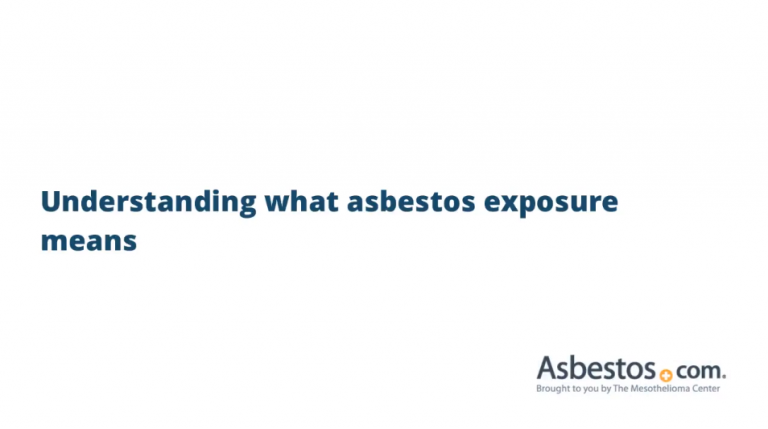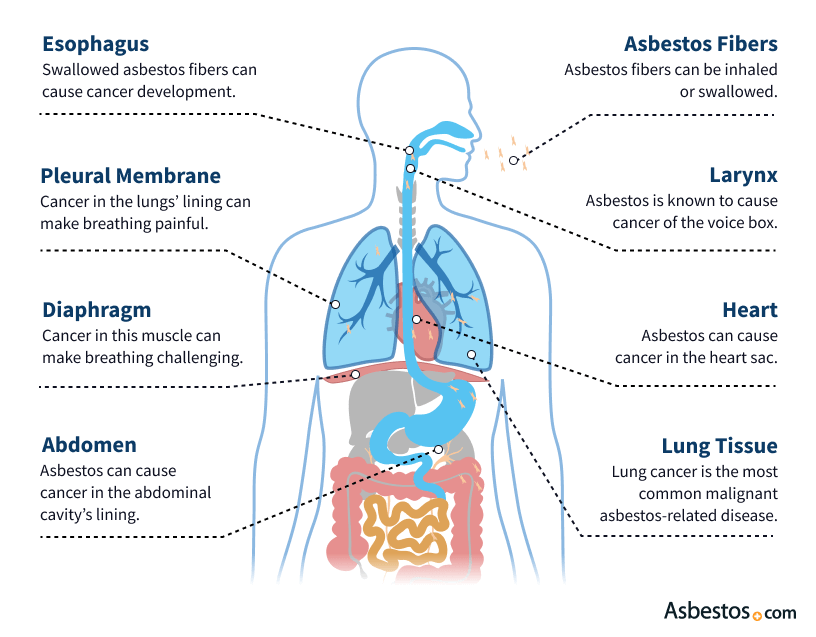Asbestos exposure sets the stage for this enthralling narrative, offering readers a glimpse into a story that is rich in detail and brimming with originality from the outset. This hazardous material, once heralded for its fire-resistant properties, has now become synonymous with grave health risks. As we delve into the long-term effects, mechanisms of disease, and the common ailments like asbestosis and mesothelioma, a clearer picture emerges of the insidious threat posed by this fibrous mineral.
Furthermore, we explore the historical context of occupational exposure, where industries such as construction and shipbuilding have faced high risks, and Artikel the essential safety protocols necessary to protect workers. Equally important is understanding the legal framework surrounding asbestos, including the rights of workers to seek compensation for exposure-related illnesses. Lastly, we will Artikel safe removal procedures and the vital role of certified professionals in abatement, ensuring that this dangerous substance is dealt with responsibly and efficiently.
Health Risks Associated with Asbestos Exposure
Asbestos exposure poses significant health risks, particularly due to the nature of its fibres and how they interact with human tissues. Over the decades, numerous studies have established a clear link between asbestos and various severe health conditions, primarily affecting the respiratory system. Understanding these risks is crucial for both those who have been exposed in occupational settings and the general public, as the consequences may manifest years after initial exposure.
The mechanisms through which asbestos fibers induce disease are complex. When inhaled, these microscopic fibres can become lodged in the lung tissue, resulting in chronic inflammation. This prolonged inflammatory response can lead to cellular changes, including fibrosis and malignancies. The fibres are resilient and resist degradation, allowing them to persist in the lungs for decades, exacerbating their harmful effects. Moreover, asbestos-related diseases often develop insidiously, complicating early detection and diagnosis.
Common Diseases Linked to Asbestos
Several serious health conditions are strongly associated with asbestos exposure. Awareness of these diseases is vital for early recognition and intervention. The following conditions exemplify the health risks posed by asbestos:
- Asbestosis: This chronic lung disease results from the inhalation of asbestos fibres, leading to scarring of lung tissue. Symptoms include persistent cough, shortness of breath, and chest tightness, which may worsen over time. Individuals with asbestosis are at increased risk of developing lung cancer.
- Mesothelioma: A rare and aggressive cancer primarily linked to asbestos exposure, mesothelioma affects the pleura (lining of the lungs) or peritoneum (lining of the abdomen). Symptoms emerge years after exposure and can include chest pain, difficulty breathing, and abdominal pain. The prognosis for mesothelioma remains poor, with limited treatment options available.
- Lung Cancer: Asbestos exposure significantly increases the risk of lung cancer, particularly among smokers. The combination of smoking and asbestos exposure creates a multiplicative effect on cancer risk. Symptoms often do not present until the disease is advanced, making early diagnosis challenging.
“The latency period for asbestos-related diseases can range from 10 to 50 years, emphasizing the critical need for awareness and monitoring among those at risk.”
Other conditions associated with asbestos exposure include pleural plaques, pleural effusion, and chronic obstructive pulmonary disease (COPD). Given the long-term health implications and the lack of a safe level of exposure, comprehensive regulations and awareness campaigns are essential for protecting current and future generations from the dangers of asbestos.
Occupational Exposure to Asbestos: Asbestos Exposure

Asbestos has been extensively used in various industries for its unique properties, such as fire resistance and insulation. However, its fibrous nature poses significant health risks, particularly in occupational settings. Workers in certain industries have historically faced higher exposure levels, leading to severe health implications. Understanding these industries and the safety protocols in place is essential for current and future workers.
Industries with High Asbestos Exposure Risks
Certain industries have a notorious reputation for asbestos exposure due to the historical and widespread use of asbestos-containing materials. These include:
- Construction: Workers involved in building and renovation often encounter asbestos in insulation, roofing materials, and fireproofing products.
- Shipbuilding: Asbestos was extensively used in shipbuilding for insulation and fire protection, putting shipyard workers at risk.
- Manufacturing: Industries producing asbestos-containing products, such as brake linings, flooring tiles, and textiles, have historically exposed workers to high levels of asbestos fibres.
- Mining: Miners extracting asbestos ore faced direct exposure to high concentrations of asbestos in their working environment.
- Demolition: Workers involved in dismantling buildings and infrastructure often disturb asbestos materials, releasing fibres into the air.
Safety Protocols and Regulations for Handling Asbestos
To mitigate the risks associated with asbestos exposure, various safety protocols and regulations have been established. The importance of adhering to these protocols cannot be overstated, as they are designed to protect workers’ health and safety. Key measures include:
- Personal Protective Equipment (PPE): Workers must wear appropriate PPE, including respirators, gloves, and protective clothing, to minimise exposure.
- Training and Awareness: Employers are required to provide training on asbestos handling, risks, and safety measures to all employees potentially exposed.
- Air Monitoring: Regular monitoring of air quality in asbestos work areas is essential to ensure exposure levels remain within legal limits.
- Control Measures: Implementing engineering controls, such as ventilation systems and wetting down materials to prevent dust, is vital in reducing airborne asbestos fibres.
- Regulatory Compliance: Adherence to local and national regulations, such as the Control of Asbestos Regulations 2012 in the UK, is mandatory.
Guide for Workers to Minimise Asbestos Exposure
For workers in industries with potential asbestos exposure, understanding how to minimise risks is crucial. The following guidelines provide essential steps for protecting oneself while on the job:
- Always Assume Asbestos is Present: In buildings constructed before 2000, treat all materials as potentially containing asbestos unless proven otherwise.
- Follow Safety Procedures: Adhere strictly to all safety protocols and procedures established by your employer.
- Utilise Proper PPE: Ensure that you are equipped with and wearing the correct PPE before commencing any work that may disturb asbestos.
- Do Not Disturb Asbestos Materials: Avoid unnecessary disruption of materials suspected to contain asbestos. If removal is necessary, it should be carried out by licensed professionals.
- Report Concerns: Immediately inform your supervisor if you suspect that asbestos is present or if you encounter damaged materials that may contain asbestos.
“Awareness and adherence to safety protocols are the first lines of defence against the risks associated with asbestos exposure.”
Legal and Regulatory Framework Surrounding Asbestos

The legal and regulatory landscape surrounding asbestos is crucial in safeguarding public health and ensuring a safe working environment. Governments worldwide have established a comprehensive suite of laws and regulations aimed at minimising asbestos exposure and managing the risks associated with its use. This framework not only governs the use and removal of asbestos but also Artikels the rights of workers who may be affected by asbestos exposure.
The most significant laws governing asbestos in the UK include the Control of Asbestos Regulations 2012, which mandates the management and control of asbestos in non-domestic properties. These regulations enforce strict guidelines on how asbestos must be handled, including its identification, risk assessment, and safe removal. The Health and Safety at Work Act 1974 also plays a pivotal role by placing the onus on employers to ensure, so far as is reasonably practicable, the health and safety of their workers. In essence, these laws work collaboratively to create a safer environment for individuals potentially exposed to asbestos.
Government Agencies and Their Role
Government agencies play a fundamental role in the enforcement of asbestos regulations and the protection of public health. In the UK, the Health and Safety Executive (HSE) is the primary body responsible for enforcing health and safety legislation, including regulations pertaining to asbestos. The HSE provides guidance for managing asbestos risks, conducts inspections, and can issue fines and enforcement notices for non-compliance.
Additionally, local authorities work in conjunction with the HSE to monitor compliance with asbestos regulations in their respective areas. They have the authority to investigate reported cases of asbestos exposure, ensuring that appropriate measures are taken to mitigate risks. The collaboration between national and local agencies is vital for effective oversight and enforcement of asbestos legislation.
Workers’ Rights and Compensation, Asbestos exposure
In the realm of occupational health, workers exposed to asbestos have specific rights related to claims and compensation. Under the law, individuals diagnosed with asbestos-related diseases, such as asbestosis or mesothelioma, are entitled to seek compensation from their employers if negligence can be established. This often involves proving that the employer failed to adhere to the regulatory framework governing asbestos safety, thus exposing workers to unnecessary risks.
Furthermore, there are several avenues through which workers can claim compensation. The Pneumoconiosis Etc. (Workers’ Compensation) Act 1979 allows for compensation without the need to prove fault, providing a safety net for individuals affected by asbestos-related conditions. Additionally, personal injury claims can be pursued through the civil court system, which may yield substantial compensation for medical expenses, loss of earnings, and suffering.
The legal framework supporting these rights emphasises the importance of adequate health and safety measures in the workplace and ensures that those affected by asbestos exposure have recourse to justice and support.
Asbestos Removal and Abatement Procedures

The meticulous process of asbestos removal and abatement is imperative for safeguarding public health, particularly in properties built before the 1980s, when the use of asbestos was prevalent. This procedure necessitates a combination of stringent safety measures, expert knowledge, and regulatory compliance to effectively eliminate asbestos-containing materials (ACMs) while minimising health risks to workers and occupants alike.
Step-by-Step Procedure for Safe Asbestos Removal
The removal of asbestos requires a systematic approach to ensure safety and compliance with legal standards. The following steps are crucial in the safe abatement of asbestos:
- Initial Assessment: Conduct a thorough inspection to identify the presence of asbestos materials and evaluate the extent of exposure risks.
- Risk Assessment: Determine the condition of the ACMs; if they are intact and undisturbed, encapsulation may be a safer option than removal.
- Notification: Inform relevant authorities and stakeholders, including building occupants, about the planned asbestos removal process.
- Preparation: Seal off the work area using polythene sheeting and create negative air pressure to prevent asbestos fibres from escaping.
- Personal Protective Equipment (PPE): Ensure all workers wear appropriate PPE, such as respirators, disposable coveralls, and gloves.
- Safe Removal: Wet the asbestos materials to reduce dust and carefully remove them, ensuring no fibres are released into the air.
- Proper Disposal: Seal the asbestos waste in designated containers and transport to licensed disposal facilities, adhering to local regulations.
- Post-Removal Clearance: Conduct air monitoring to ensure that no asbestos fibres remain in the area, allowing re-entry only after clearance.
Checklist for Property Owners to Inspect for Potential Asbestos Hazards
Property owners play a crucial role in identifying potential asbestos hazards prior to any renovation or demolition work. The following checklist serves as a guide for such inspections:
Regular inspections can prevent health risks associated with asbestos exposure.
- Examine the age of the building; properties built before 1980 are more likely to contain asbestos.
- Inspect insulation materials around pipes, boilers, and ducts for signs of asbestos.
- Check ceiling tiles and floor tiles for any labels indicating asbestos content.
- Investigate textured paints and coatings that may contain asbestos.
- Look for older roofing materials that could potentially be asbestos-based.
- Assess any areas where renovations have occurred, as disturbed materials may release fibres.
Importance of Hiring Certified Professionals for Asbestos Abatement
Engaging certified professionals for asbestos abatement is essential to ensure that the process is conducted safely and complies with legal mandates. Certified professionals possess the necessary training and expertise to handle asbestos materials effectively.
Only trained professionals should manage asbestos removal to mitigate health risks and ensure compliance with regulations.
This expertise is vital not only for the safety of the workers involved but also for the protection of the public and the environment. Professionals are equipped with specialised tools and safety equipment, and they follow established protocols that significantly reduce the likelihood of asbestos exposure during and after the removal process. Furthermore, hiring certified contractors ensures adherence to local and national regulations, thereby protecting property owners from potential legal repercussions associated with improper handling of hazardous materials.